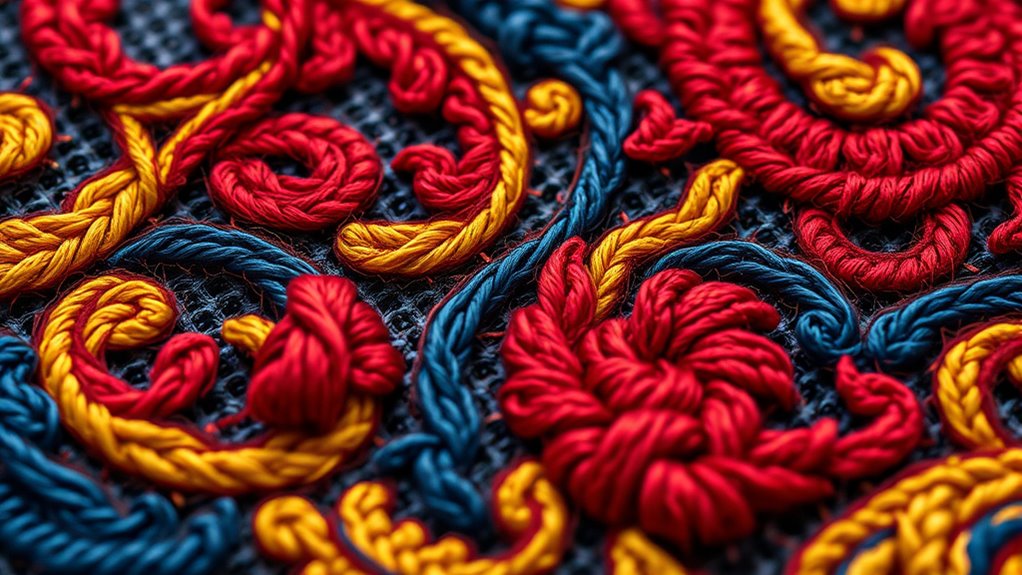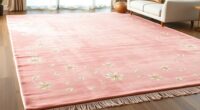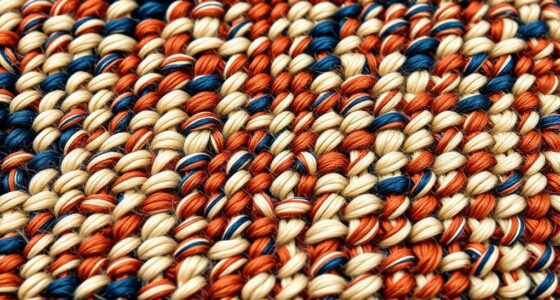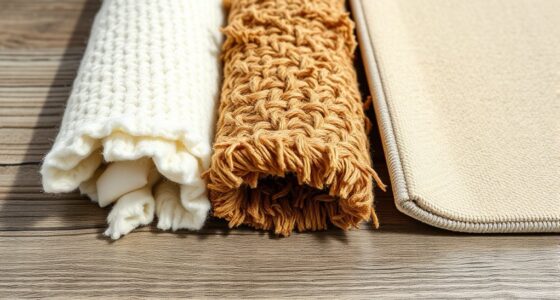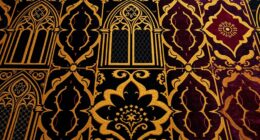To identify signature pieces by a single weaver, focus on distinctive design elements, weaving patterns, and unique motifs that reflect their style. Examine material choices, textures, and color palettes, especially those with cultural or personal significance. Look for subtle imperfections or personal touches that reveal craftsmanship. Knowing the artist’s background and provenance can also help. Continuing to explore these details will deepen your understanding of authentic masterworks and their unique signatures.
Key Takeaways
- Examine handcrafted details, irregularities, and quirks that reflect the weaver’s personal signature and craftsmanship.
- Analyze weaving patterns, motifs, and fiber choices for distinctive stylistic elements unique to the artist.
- Assess material quality, dye techniques, and color palettes that indicate the weaver’s signature style and cultural influences.
- Review provenance records, artist backgrounds, and historical context to confirm authenticity and identify signature traits.
- Compare signature motifs, techniques, and details with known works or archives to distinguish masterful, one-of-a-kind pieces.
Recognizing Distinctive Weaving Styles

To distinguish between different weaving styles, you need to pay close attention to the details that set each apart. Start by examining the fiber composition, as the type of fibers used influences texture, shine, and durability. For instance, silk creates a smooth, lustrous surface, while wool offers warmth and a softer feel. Next, analyze the weaving patterns; some styles feature tight, intricate designs, while others have more open, airy structures. Look for distinctive techniques such as twill, plain weave, or complex brocades, which reveal the weaver’s unique approach. Recognizing these elements helps you identify the origin and craftsmanship behind each piece, giving you insight into the cultural and historical context of the weaving style.
Analyzing Unique Design Elements
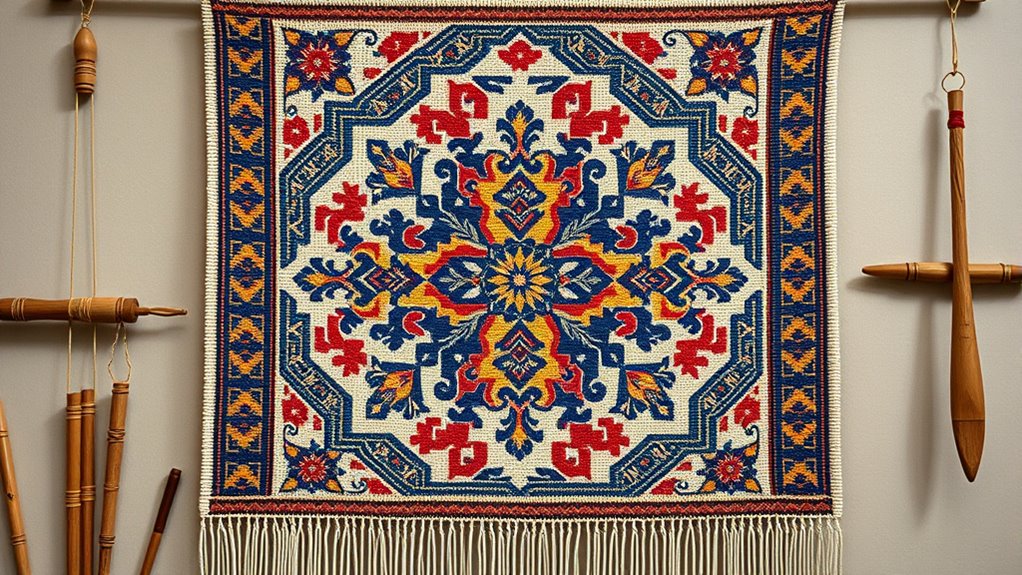
Once you’ve identified the weaving techniques and fiber types, focusing on unique design elements reveals the true character of each piece. Pay close attention to fiber patterns and weaving motifs, which distinguish signature works. These elements showcase the weaver’s creativity and intent, often reflecting cultural or personal symbolism. To analyze effectively, examine details such as symmetry, repetition, and variation within the design. Use the table below to compare key features: attention to detail is essential in discerning the subtle nuances that make each piece unique.
| Fiber Patterns | Weaving Motifs | Design Symmetry |
|---|---|---|
| Intricate geometric | Floral, abstract | Radial, bilateral |
| Bold color contrasts | Animal, cultural | Asymmetrical |
| Repetitive motifs | Symbolic patterns | Radial, grid |
This approach helps you uncover the artistry behind each signature piece.
Examining Material and Texture Choices
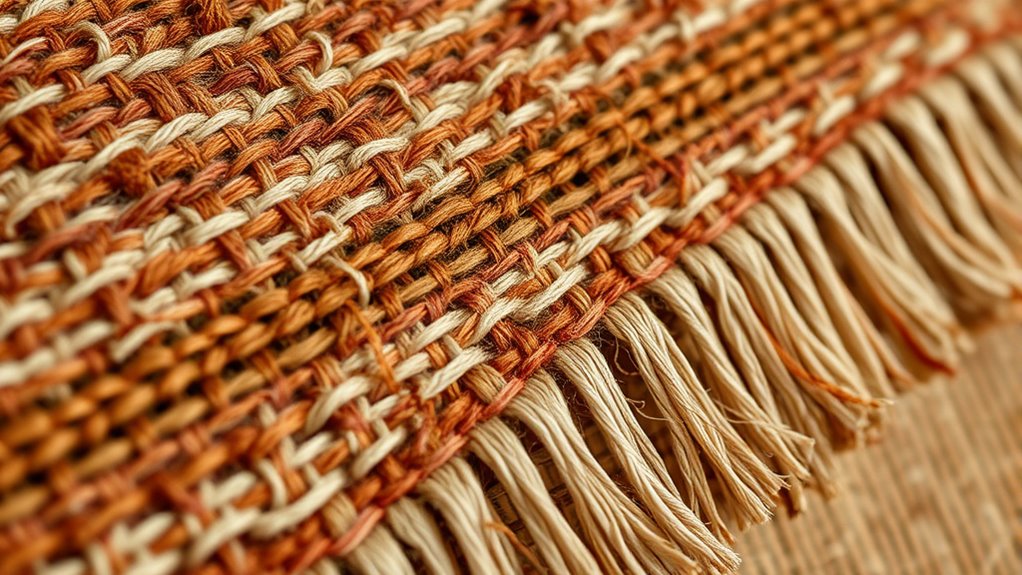
The materials you choose for weaving directly influence the piece’s overall feel and meaning. Texture variety adds depth and emotion, making each work unique. Using authentic, carefully selected materials enhances both the craftsmanship and the piece’s cultural significance. Incorporating appliance maintenance plans can also ensure the longevity of wearable textiles that integrate modern technology, blending tradition with innovation.
Material Selection Significance
Why do material and texture choices matter so much in single-weaver masterpieces? Because they directly influence the piece’s longevity and visual impact. The fiber durability ensures your artwork withstands time and handling, preserving its integrity. Dye stability affects how vibrant and lasting the colors remain, preventing fading over years. Consider these key factors:
- Selecting fibers with high fiber durability guarantees your masterpiece stays intact.
- Using dyes with proven stability keeps colors vivid and resistant to environmental fading.
- Texture choices, though not the focus here, complement the materials’ qualities.
- The combination of fiber and dye quality defines the signature look and resilience of your work.
- Understanding the contrast ratio in your materials can enhance the depth and richness of colors, making your piece more striking.
Choosing the right materials elevates your craft, making your signature piece stand the test of time.
Texture Variety and Impact
Have you ever noticed how the variety of textures in a single-weaver masterpiece can elevate its overall impact? By skillfully combining fabric manipulation techniques, you create contrasting surfaces that draw the viewer’s eye. Incorporating different weaving pattern complexities adds depth and tactile interest, making the piece more engaging. A mix of smooth, glossy areas with rougher, textured sections showcases your mastery of material and technique. These deliberate choices enhance the visual rhythm and emotional resonance of your work. Texture variety isn’t just about aesthetics; it invites viewers to explore the piece through touch and sight, amplifying its signature quality. When you thoughtfully blend fabric manipulation with weaving pattern complexity, you craft a masterpiece that resonates on multiple sensory levels.
Authenticity Through Materials
Choosing authentic materials is essential to conveying genuine craftsmanship in your weaving masterpieces. The quality of fibers you select directly impacts texture, durability, and visual appeal. To guarantee authenticity, consider these key aspects:
- Fiber Quality: Opt for natural fibers like wool, silk, or cotton, which offer rich textures and longevity.
- Dye Sourcing: Use dyes from reputable sources, preferably natural or historically accurate, to preserve color authenticity.
- Texture Choices: Select fibers that enhance the tactile experience, reflecting traditional methods.
- Material Origin: Know where your fibers and dyes come from, ensuring they align with regional or cultural authenticity.
- Incorporating AI-driven analysis can help verify the authenticity of your materials by assessing their origin and quality.
Focusing on fiber quality and dye sourcing helps you craft pieces that not only look genuine but also carry the spirit of traditional craftsmanship.
Identifying Signature Color Palettes
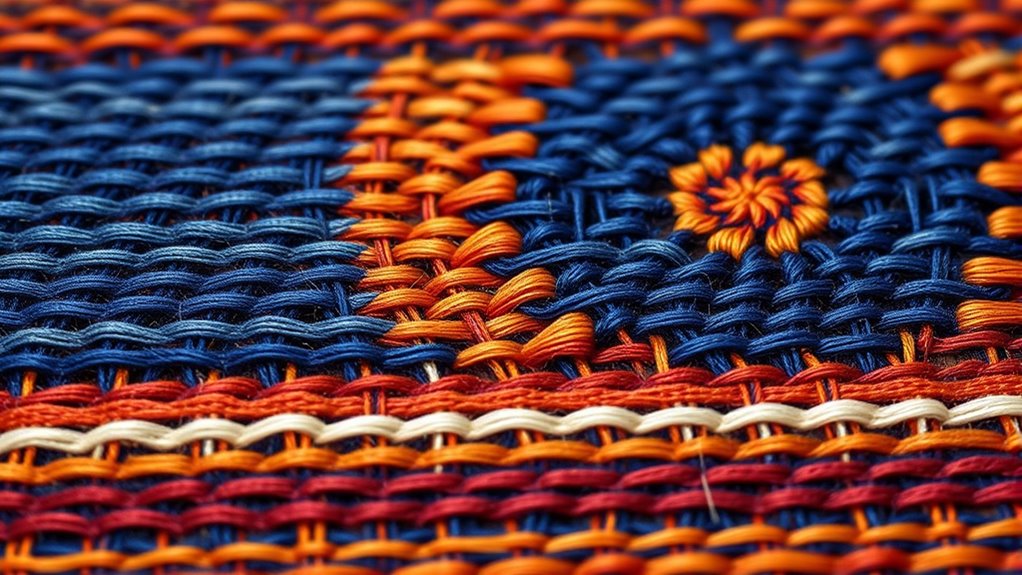
Ever wonder what makes a single-weaver’s work instantly recognizable? It’s often their signature color palette. These palettes reveal more than just aesthetic choices—they embody color symbolism, conveying specific meanings or cultural values. To identify these signatures, pay attention to dye sourcing. Some weavers use natural dyes from local plants, resulting in earthy, muted tones, while others source commercial dyes for vibrant, consistent hues. Recognizing these patterns helps you distinguish a master’s unique style. The deliberate selection of colors, combined with their cultural significance and sourcing methods, creates a visual signature that’s unmistakable. By studying these color choices, you gain insight into the weaver’s intent, cultural background, and artistic vision, making each piece a personal statement embedded in color. Additionally, understanding the color symbolism behind the palettes can deepen your appreciation for the cultural context and artistic expression involved.
Tracing Cultural and Historical Influences
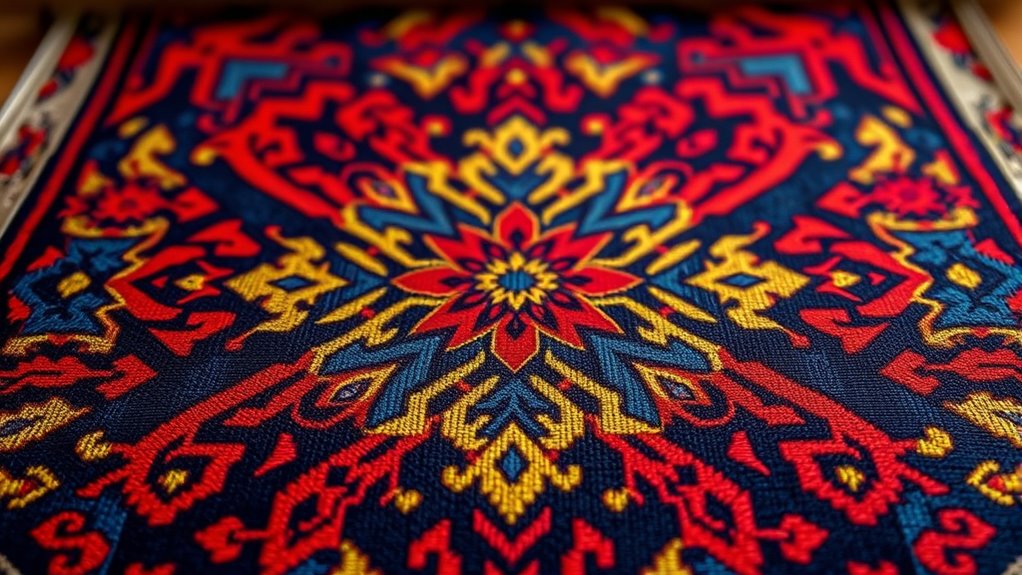
The colors a weaver selects often reflect deeper cultural and historical influences that shape their work. These choices are rooted in cultural symbolism and the historical context of their community. To understand these influences, consider:
- The use of specific colors representing religious beliefs or societal status.
- Symbols that convey stories or myths significant to their culture.
- Patterns derived from traditional designs passed down through generations.
- Materials and techniques influenced by historical events, trade, or colonization.
- The influence of cosmic connections between astrology and personal traits that may inspire certain color choices or motifs in traditional weaving.
Looking for Personal Touches and Imperfections
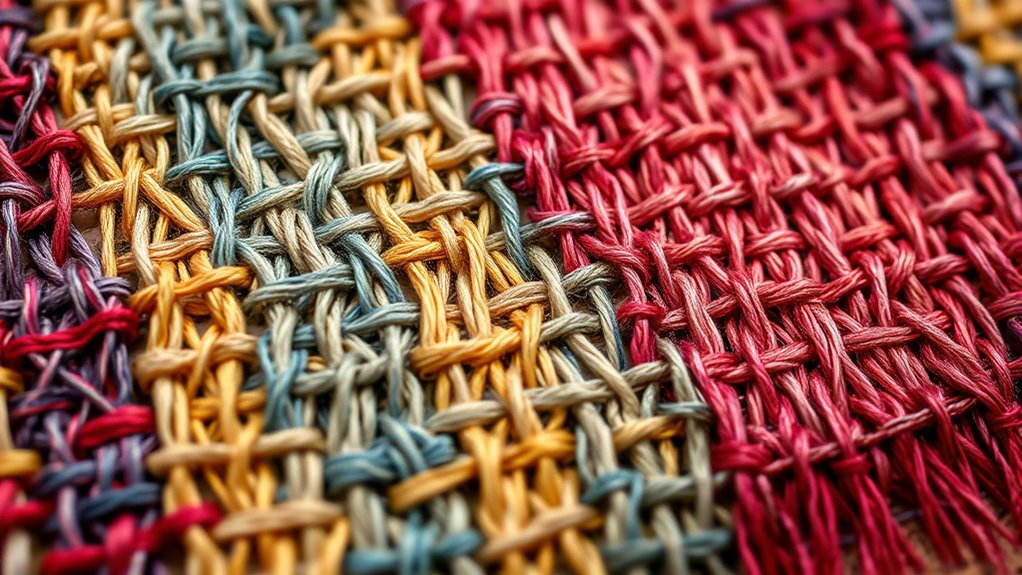
Have you ever noticed the unique marks and irregularities that make each woven piece stand out? These imperfections often reveal the imperfection charm that defines a master weaver’s work. Look closely at the stitches and weaves—small inconsistencies or uneven lines that reflect the artist’s personal fingerprints. These subtle details show that the piece wasn’t mass-produced but handcrafted with care and skill. Imperfections add character and authenticity, making each masterpiece one-of-a-kind. Instead of seeking perfection, embrace these quirks as evidence of the weaver’s personal touch. They tell a story of craftsmanship and individuality, helping you distinguish a true signature piece from a replica. Recognizing these marks deepens your appreciation and connection to the artistry behind each woven masterpiece. Exploring the handcrafted details can further enhance your understanding of the artisan’s skill and the unique qualities that set each piece apart.
Understanding Provenance and Artist Backgrounds
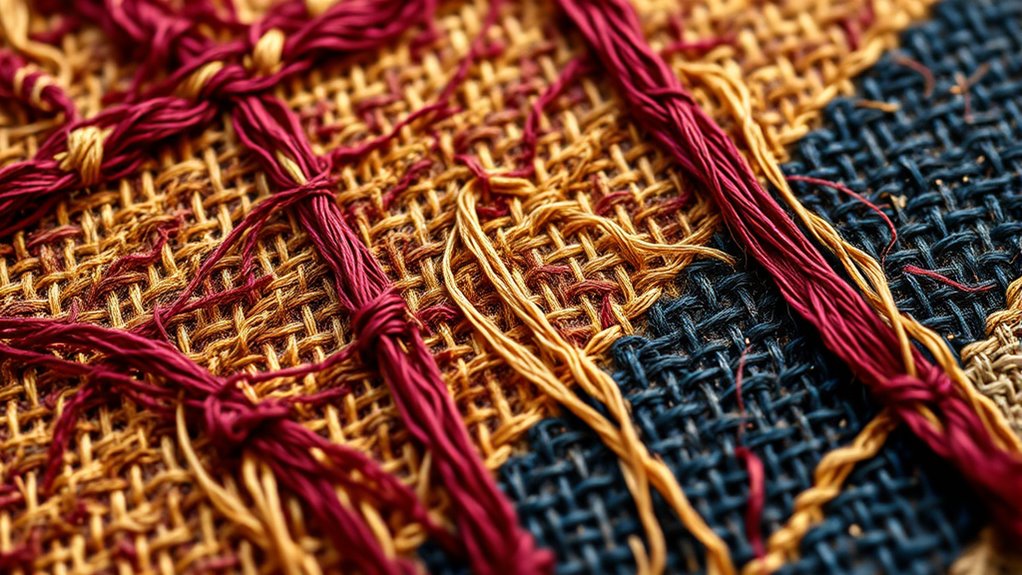
Understanding the origins of a weaving helps you confirm its authenticity and value. You should explore the artist’s career highlights to appreciate their unique style and contributions. Learning about verification methods guarantees you confidently identify genuine masterpieces. Additionally, recognizing beginners guides can provide foundational knowledge for assessing the quality and provenance of artworks.
Tracing Artwork Origins
Tracing the origins of an artwork reveals essential insights into its history, authenticity, and value. To understand its background, focus on key clues:
- Fiber dyeing techniques: Examine the dyes used, as specific methods can indicate a particular region or period.
- Loom mechanisms: Study the weaving tools; unique loom features help attribute pieces to certain artisans or cultures.
- Provenance records: Review ownership history, sales, and exhibitions to map out the artwork’s journey.
- Artist’s background: Research the weaver’s training and regional influences, which often shape signature styles.
- Signature styles: Recognizing preppy dog names or other breed-inspired themes can also help identify the cultural context of the artwork.
Artist’s Career Highlights
Discovering an artist’s career highlights provides essential context for understanding their work’s provenance and significance. You’ll see how their influence shaped fiber technology and responded to market trends over time. Recognizing key milestones can reveal shifts in style or technique that mark their evolution, adding depth to signature pieces. Additionally, understanding their industry impact can offer insights into the broader art movement and technological advancements during their active years.
Authenticity Verification Methods
Authenticity verification begins with examining the provenance of a fiber artwork, which provides a documented history of its ownership and origin. This trace helps confirm if the piece aligns with known works by the artist. To verify authenticity, consider these key factors:
- Review records of fiber dyeing techniques used, ensuring they match the artist’s signature methods.
- Analyze weaving patterns for unique stylistic elements or motifs characteristic of the artist’s signature style.
- Cross-reference documentation with museum or gallery archives to confirm provenance.
- Consult expert appraisals focusing on material authenticity, craftsmanship, and historical context.
Comparing Techniques Across Different Works
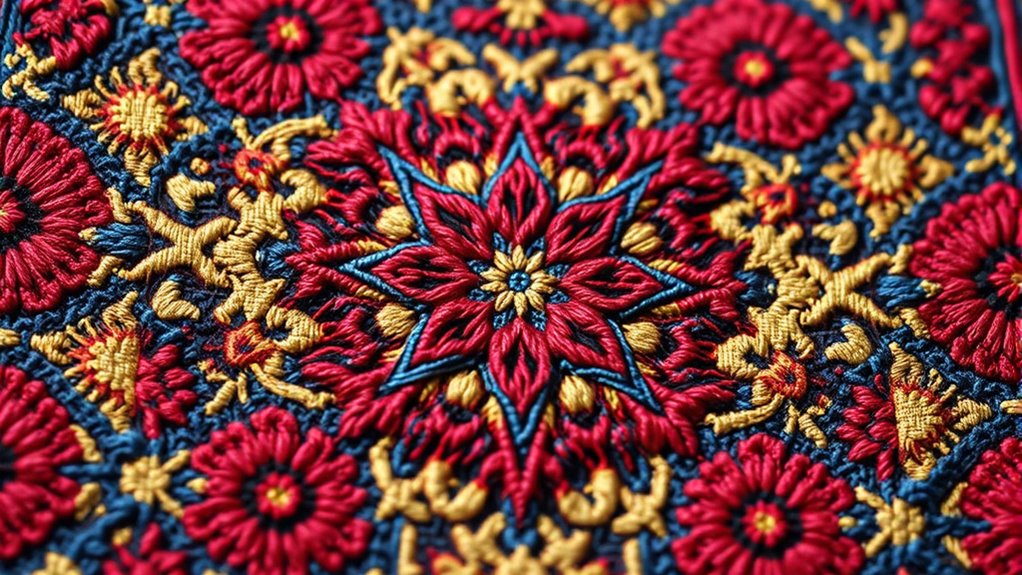
By examining the techniques used across different works, you can gain insight into the master weaver’s evolving style and craftsmanship. Focus on fiber density—notice how tightly or loosely the fibers are woven, revealing shifts in skill or intent. Pay attention to weaving symmetry; consistent patterns indicate deliberate precision, while variations may reflect experimentation or different cultural influences. Comparing these elements across multiple pieces helps you identify underlying techniques that define the weaver’s signature. For example, a consistent fiber density might highlight their mastery of tension control, while recurring symmetry patterns can reveal their aesthetic preferences. Recognizing these subtle differences enhances your understanding of their artistic development and the unique qualities that distinguish their signature works.
Consulting Expert Opinions and Documentation
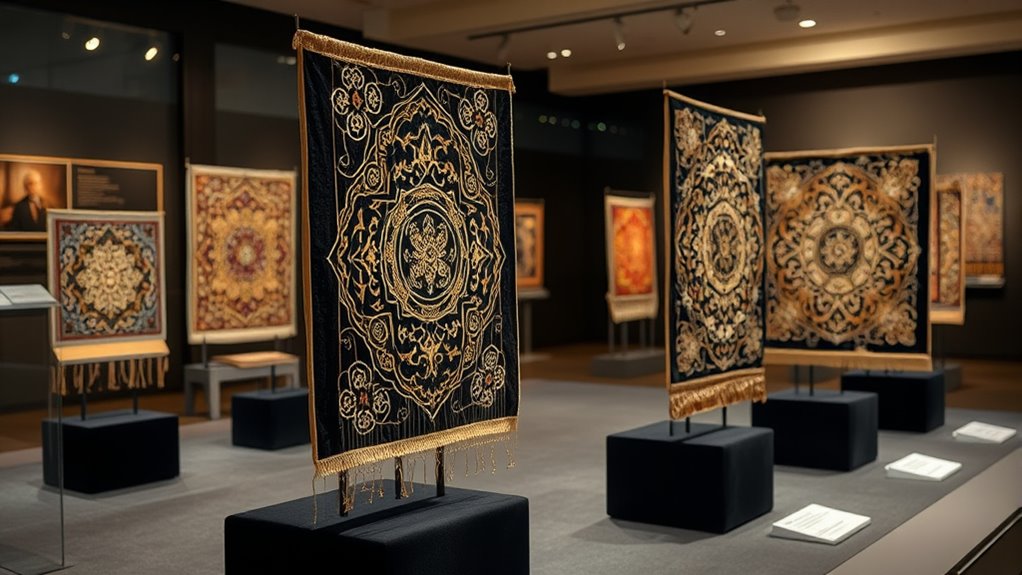
Consulting expert opinions and reviewing documentation can substantially deepen your understanding of the master weaver’s techniques and intentions. An expert interview provides firsthand insights into their creative process, revealing subtle nuances. Documentation review, such as weaving records and historical notes, helps verify authenticity and context. To get a clearer picture, consider:
- Conducting interviews with weaving specialists or historians
- Examining archival records and provenance documents
- Analyzing detailed sketches or pattern notes
- Cross-referencing expert opinions with existing literature
Frequently Asked Questions
How Can I Authenticate a Weaver’s Signature Piece?
To authenticate a weaver’s signature piece, start with technique analysis to examine the craftsmanship and materials used, ensuring they match the artist’s known style. Next, conduct signature verification by comparing the signature details to verified examples. Pay attention to stitching patterns, color choices, and weaving methods that are unique to the artist. Combining these steps helps you confidently confirm the piece’s authenticity and value.
What Are Common Mistakes When Identifying Signature Woven Artworks?
Imagine mistaking a signature piece due to technique misinterpretations—it’s a common mistake. When identifying signature woven artworks, you might wrongly attribute a piece because you overlook subtle stylistic details or misread the signature. Be cautious of signature misattributions, especially if the artist’s style evolved over time. Always verify provenance and compare techniques carefully to avoid errors, ensuring you accurately recognize genuine masterpieces.
How Does Provenance Influence the Value of a Weaving Masterpiece?
Provenance profoundly influences the value of a weaving masterpiece because it provides insight into its history and authenticity. As you explore weaving history and collector insights, you’ll see that a well-documented provenance assures buyers of the piece’s origin and rarity. This connection enhances its desirability and worth, making provenance a crucial factor when evaluating the importance and value of a weaving masterpiece in the art market.
Are There Specific Tools to Analyze Weaving Techniques Precisely?
Imagine a master weaver’s loom as a treasure chest, holding secrets inside. You can unseal these secrets with tools like digital analysis and microscopic examination, acting as your keys. Digital analysis reveals intricate patterns and thread counts, while microscopic examination uncovers fiber details invisible to the naked eye. Together, these tools help you analyze weaving techniques precisely, ensuring you understand each masterpiece’s craftsmanship and authenticity.
How Do I Differentiate Between Authentic and Reproduction Weaver Pieces?
To differentiate authentic from reproduction weaver pieces, you should examine the weaver signature techniques, which reveal the artist’s unique style. Look closely at the woven material authenticity, such as the quality of threads and craftsmanship details. Authentic pieces often show consistent, intricate work, while reproductions may lack these subtle details. Developing an eye for these signature techniques helps you identify genuine weaver masterpieces confidently.
Conclusion
By paying attention to weaving styles, design elements, and material choices, you can uncover a Weaver’s signature pieces. For example, if you find a textile with bold colors and intricate patterns reminiscent of a specific region’s tradition, you might trace it back to a master weaver. Trust your eye, consult experts, and explore the piece’s history—you’ll uncover stories woven into every thread, making each discovery truly special.
